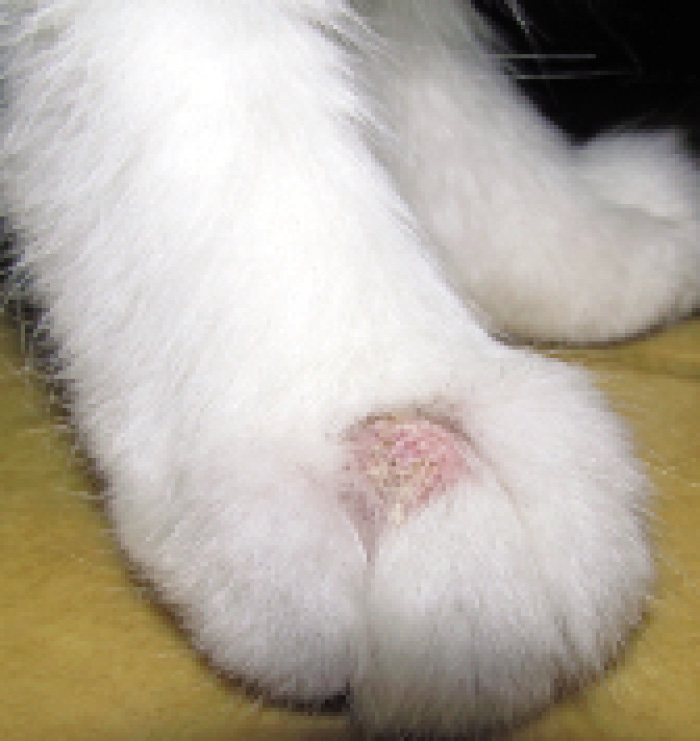The fungal infection called ringworm is spread via direct contact with fungal spores. Contact could be from an animal with an infection, combs or bedding, or anywhere in the environment in which spores have been shed, including on furniture and carpets. Unfortunately, ringworm can be difficult to eliminate once it gets established in a kennel, home, cattery, or shelter, as spores can survive in the environment for up to 18 months.
While ringworm itself is not life threatening, it can spread to family members (making it a zoonotic disease) and other pets. Areas of damaged skin are susceptible to bacterial infections.
 Ringworm—medically known as dermatophytosis—is caused by a fungus of the group dermatophytes. Ringworm got its name from the red ring it causes around a hairless area, not because it is caused by a worm or parasite. Ringworm is one of the more common skin problems seen in cats, and Microsporum canis is the most common fungus involved.
Ringworm—medically known as dermatophytosis—is caused by a fungus of the group dermatophytes. Ringworm got its name from the red ring it causes around a hairless area, not because it is caused by a worm or parasite. Ringworm is one of the more common skin problems seen in cats, and Microsporum canis is the most common fungus involved.
Signs of Ringworm
The face, ear tips, tail, and feet are common areas for ringworm to occur. Cats with ringworm will have scaly areas, often with hair loss, that may occur in a circular pattern, but not always. Kittens are more susceptible than healthy adult cats due to their immature immune systems. Some infected cats, especially longhairs, may not show any signs at all, but can still be carriers.
Family members may develop the characteristic red rings. Alopecia (hair loss) is most commonly due to hair shafts that are weakened by the fungus as opposed to intense chewing or itching. Secondary bacterial infections may cause redness, inflammation, and erosions. Nail bed infections can cause soreness and are difficult to eradicate.
Diagnosis can usually be achieved at your veterinary clinic. Your veterinarian will do a full physical exam. Then, your cat will be checked out with a Wood’s lamp, which is an ultraviolet light under which fungus-coated hair will glow with a bright neon green color. Individual hairs from areas that fluoresce may be looked at under the microscope for spores. If there is any question, some hairs from the affected areas will be placed on special media and cultured to determine if the fungus is present.
Treatment
A healthy adult cat exposed to this dermatophyte may be able to fend it off right from the start or clear the infection on her own with a healthy immune system. That can take from nine to 12 months, however, and during that time, infectious spores can infect other pets and people in the family, and can leave the environment as a source of repeated infections.
Treatment usually starts with a topical therapy, such as a lime sulfur dip or shampoo. This should be repeated twice a week for a minimum of four to six weeks. Ideally, your cat should have two negative fungal cultures two weeks apart to be considered clear. Currently, most veterinarians dispense an oral antifungal medication such as itraconazole plus the topical treatments. Many cats require weeks if not months of treatment to truly be clear of the infection.
If you own multiple pets, you can try separating any obviously infected animals from uninfected ones and hope for the best, but it’s often simplest to just treat all your pets. Young children and anyone who is immunocompromised should avoid contact with infected pets.
Home Environment
While treating any infected animals, you also need to wage a full-scale cleaning war on the environment, which means any room that your cat has been in. Start by wiping off hard surfaces such as counters and floors with a dilute bleach solution. Many household cleaners won’t kill the spores, so stick to bleach. You need to do this weekly at a minimum until your cat is declared ringworm-free.
Meanwhile, you need to vacuum thoroughly, cleaning out cracks by the wall and under furniture. The vacuum bag should be thrown out or the bagless dirt cup washed. Steam cleaning carpets can help to pick up spores but won’t kill them. Wash curtains, bedding, pet beds, etc. on a hot cycle with added bleach, if you can. Use the hot setting on the dryer too. If things can’t be cleaned, discard them. Replace furnace and air conditioner filters weekly. If it is warm and you have fans running, aim them outside to help remove any spores that get in the air.
Prevention
How can you avoid ringworm? If you are adding a cat or kitten to your home, have her screened for ringworm using a Woods lamp or cultures if there are lesions before bringing her home. If one of your feline family members is diagnosed with ringworm, confine her to a single room. Have any other pets checked and quarantine and treat them as needed. Follow through with a complete treatment plan until you have two negative tests two weeks apart. Be sure that your house has been thoroughly cleaned, as described earlier.




